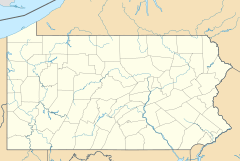Northkill Creek facts for kids
Quick facts for kids Northkill |
|
|---|---|
|
Location of the mouth in Pennsylvania
|
|
| Country | United States |
| State | Pennsylvania |
| Cities | Bernville, Pennsylvania, Strausstown, Pennsylvania, Shartlesville, Pennsylvania, New Shaefferstown, Pennsylvania |
| Physical characteristics | |
| Main source | Blue Mountain, Pennsylvania |
| River mouth | Tulpehocken Creek Pennsylvania, United States 40°25′31″N 76°06′45″W / 40.4252°N 76.1124°W |
| Length | 11 mi (18 km) |
| Basin features | |
| Basin size | 42 sq mi (110 km2) |
| Tributaries |
|
Northkill Creek is a stream mostly found in Berks County, Pennsylvania. It flows into Tulpehocken Creek. This creek is part of the larger Schuylkill River and Delaware River water systems. Northkill Creek and its smaller streams are known for having many high-quality trout.
Contents
Where is Northkill Creek?
Northkill Creek starts in a place called Northkill Gap. This is on Blue Mountain near Shartlesville. The creek flows for about 11 miles (18 km). It moves south until it joins Tulpehocken Creek. This meeting point is just south of Bernville.
What is a Watershed?
A watershed is an area of land where all the water drains into one main river or stream. Northkill Creek's watershed covers about 42 square miles (109 km²). This area includes parts of several townships in Berks County. It also covers parts of two townships in Schuylkill County.
The Little Northkill Creek is a smaller stream that feeds into Northkill Creek. It drains more than half of the watershed's area. It also provides about 60% of the total water flow to Northkill Creek.
Rocks and Water
The ground under the creek is mostly made of sandstone. It also has layers of shale, slate, and other rock pieces. The rocks on Blue Mountain are rich in quartz. Shale rocks are found on gentler slopes. These types of rocks do not help much to stop acidic pollution in the water. They also don't hold much water, which can make the creek less resistant to dry periods.
How Land is Used Around the Creek
Around the Northkill Creek, about 61% of the land is used for farming. Another 37% is covered by forests. Sadly, about 2,000 acres (8 km²) of farmland are lost each year. This land is changed for other uses, like building homes or businesses.
Stream Health and Fish Life
The Pennsylvania Department of Environmental Protection checks the health of streams. The part of Northkill Creek from its start to the I-78 bridge is called an "Exceptional Value stream." This means it has very clean water and supports special plants and animals. The rest of the creek is called a "Cold Water Fishery." This means it's a good place for fish that like cold water.
Trout and Other Fish
The Pennsylvania Fish and Boat Commission says Northkill Creek and its smaller streams are "wild trout streams." This means they are important places where wild trout are born and grow up. The creek is also stocked with brown and brook trout. This means more trout are added to the creek for fishing.
In the past, American eels lived in the watershed. However, dams have caused their numbers to go down. Other fish found here include cutlips minnow, common shiner, eastern blacknose dace, creek chub, and white sucker.
Challenges to Stream Quality
The quality of the creek's water faces some challenges:
- Acid Rain: Rain can become acidic, mostly from pollution from power plants. This acid rain can harm the water.
- Farm Pollution: Water from farms can carry nitrates and phosphates into the creek. These can be harmful to fish and other life.
- Development: New buildings and roads can cause problems. They can lead to silt (dirt) in the water, road salt, animal waste, and sewage.
History of Northkill Creek
The water, plants, and animals of Northkill Creek were important for the Lenape people. They also helped the first European settlers who came to the area.
Early Settlers
In the early 1700s, groups like the Anabaptists and Lutherans settled near Northkill Creek. In 1736, several Amish families bought land along the creek. This area became the Northkill Amish Settlement. It was the very first organized Amish community in the United States.
More than 150 people lived in this community. They built stone houses and planted apple orchards. They grew crops like hay, wheat, and rye. Over time, this community moved to other places. In 1754, a place called Fort Northkill was built. It was about two miles (3 km) east of Strausstown, near the creek.


